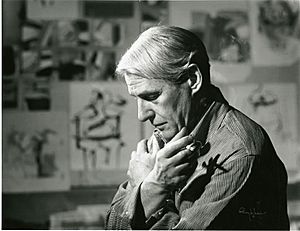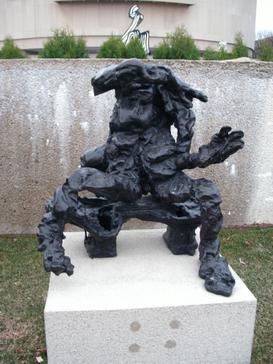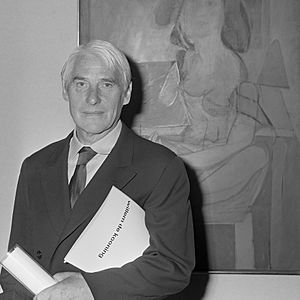Willem de Kooning facts for kids
Quick facts for kids
Willem de Kooning
|
|
|---|---|

De Kooning in his studio in 1961
|
|
| Born | April 24, 1904 Rotterdam, Netherlands
|
| Died | March 19, 1997 (aged 92) East Hampton, New York
|
| Nationality | Dutch, American |
| Known for | Abstract expressionism |
|
Notable work
|
Woman I, Easter Monday, Attic, Excavation |
| Spouse(s) | Elaine de Kooning |
| Awards | Presidential Medal of Freedom (1964) Edward MacDowell Medal (1975) National Medal of Arts (1986) Praemium Imperiale (1989) |
Willem de Kooning (born April 24, 1904 – died March 19, 1997) was a famous Dutch-American artist. He was known for his unique style called abstract expressionism. Born in Rotterdam, Netherlands, he moved to the United States in 1926. He later became an American citizen in 1962. In 1943, he married another talented painter, Elaine Fried.
After World War II, de Kooning became a key figure in a new art movement. This style was known as abstract expressionism or "action painting". He was part of a group called the New York School. Other artists in this group included Jackson Pollock and his wife, Elaine de Kooning. A big art show of de Kooning's work at the MoMA in 2011–2012 made him one of the most recognized artists of the 20th century.
Contents
Discovering Willem de Kooning's Life
Willem de Kooning was born in Rotterdam, Netherlands, on April 24, 1904. His parents, Leendert de Kooning and Cornelia Nobel, divorced in 1907. Willem lived with his father first, then with his mother. He left school in 1916 and started working as an apprentice for a company that made commercial art. Until 1924, he took evening classes at the Academy of Fine Arts in Rotterdam. This school is now called the Willem de Kooning Academie.
Moving to America and Starting His Art Career
In 1926, de Kooning traveled to the United States as a stowaway on a British ship. He arrived in Newport News, Virginia, on August 15. He stayed at a Dutch sailors' home in Hoboken, New Jersey, and found work painting houses. In 1927, he moved to Manhattan, New York, and set up his own art studio. He earned money by doing carpentry, house painting, and commercial art jobs.
De Kooning started painting in his free time. In 1928, he joined an art colony in Woodstock, New York. He also began to meet other modern artists in Manhattan. These included Stuart Davis, Arshile Gorky, and John D. Graham. De Kooning called them his "Three Musketeers." Gorky became a very close friend and a big influence on de Kooning's art for many years.
Working on Public Art Projects
In 1934, de Kooning joined the Artists Union. In 1935, he worked for the Federal Art Project. This government program helped artists during the Great Depression. He designed several murals for public buildings, though none were actually built. One of his sketches was shown at the Museum of Modern Art. This was his first time showing his art in a group exhibition.
In 1937, de Kooning had to leave the Federal Art Project because he was not yet an American citizen. From then on, he worked full-time as an artist. He earned money from art commissions and by teaching lessons. That same year, he helped paint a mural called Medicine for the 1939 World's Fair in New York. This mural caught the attention of art critics.
His Artistic Style and Friendships
De Kooning met his wife, Elaine Fried, at the American Artists School in New York. She was 14 years younger than him. They got married on December 9, 1943. De Kooning began painting his first series of portrait paintings around this time. These included standing or sitting men, sometimes combined with self-portraits.
Early in his career, de Kooning's work was influenced by Gorky's surreal art and by Pablo Picasso. This changed when he met the younger painter Franz Kline. Kline also worked with a realistic style and liked using only one color. Kline, who died young, became one of de Kooning's closest artist friends. Kline's influence can be seen in de Kooning's "black images" from this time.
Becoming an Abstract Expressionist
In the late 1940s and early 1950s, de Kooning joined other artists like Jackson Pollock and Franz Kline. They wanted to create a new art style, different from Cubism, Surrealism, and Regionalism. Their art used strong, emotional brushstrokes and abstract shapes. This movement became known as 'Abstract Expressionism', sometimes called 'Action Painting', and the 'New York School'.
Between 1948 and 1953, de Kooning became more famous for his art. He always tried new things and avoided repeating himself. In the late 1950s, his art began to change. He moved away from painting figures, especially women, and explored more abstract images. He became a US citizen on March 13, 1962. The next year, he moved to a small house in East Hampton. He built a studio nearby and lived there for the rest of his life.
Later Life and Legacy
Towards the end of his life, in the late 1980s, de Kooning began to lose his memory. He had been suffering from Alzheimer's disease. This led to discussions among art experts about how much he was able to control his art in his later years. De Kooning painted his last works in 1991. He passed away in 1997 at the age of 92.
Willem and Elaine de Kooning's Marriage
Elaine admired Willem's art even before they met. In 1938, her teacher introduced her to de Kooning in a cafeteria in Manhattan. She was 20 and he was 34. After they met, he started teaching her how to draw and paint. They painted in Willem's art studio. He was known for being very strict about her work. He often made her draw and redraw figures until they were perfect. He even destroyed some of her drawings. But this pushed Elaine to work harder for precision and beauty in her art. When they married in 1943, she moved into his studio, and they continued to share their art space.
They separated in 1957. During their separation, Elaine stayed in New York and faced challenges. Willem moved to Long Island. Both continued to paint. Even though they were separated for almost twenty years, they never divorced. They eventually got back together in 1976.
Exploring de Kooning's Artworks
Early Artworks
De Kooning's paintings from the 1930s and early 1940s were abstract still-lifes. They featured geometric or biomorphic (life-like) shapes and bright colors. These works showed influences from his friends and other famous artists like Arp, Joan Miró, Mondrian, and Pablo Picasso. During these years, de Kooning also painted a series of lonely male figures. Many of these were never finished.
Black and White Abstract Art
By 1946, de Kooning started a series of black and white paintings. He continued this series until 1949. In 1948, he had his first solo art show. It mostly featured these black and white works, though some had touches of bright color. De Kooning's black paintings are important in the history of abstract expressionism. This is because of their complex shapes, mixed materials, and unique painting style.
The Famous Woman Series

De Kooning painted women often in the early and late 1940s. But it was not until 1950 that he focused only on the female subject. His well-known Woman series began in 1950 and ended with Woman VI. These paintings were influenced by Picasso. They showed figures that were broken apart in an aggressive way, along with the space around them.
De Kooning helped lead the art world in the 1950s into the new movement of American abstract expressionism. The female figure was a very important symbol in de Kooning's art and his life. The Woman paintings are considered very important works of art. They reflect the history after World War II and the American feminist movement. Also, the materials he used (oil, enamel, and charcoal on canvas) made these paintings unique for his time.
Notable Works by de Kooning
De Kooning is famous for paintings such as: Woman III (1953), Woman VI (1953), Interchange (1955), and Police Gazette (1955). Some of his well-known sculptures include Clamdigger (1972/1976) and Seated Woman on a Bench (1972/1976).
Art Exhibitions
Willem de Kooning had many solo art shows from 1948 to 1966. Many were in New York, but also across the country and internationally. He had fourteen different exhibitions. In some years, like 1953, 1964, and 1965, he even had two shows per year. His art was shown at famous galleries and museums. Most of these exhibitions lasted for about three weeks to one month. A recent exhibition, "De Kooning: Five Decades," took place in New York City in 2019.
See also
 In Spanish: Willem de Kooning para niños
In Spanish: Willem de Kooning para niños
- Abstract expressionism
- Action painting
- American Figurative Expressionism
- New York Figurative Expressionism
- Elaine de Kooning
- Impasto
- Women in art
- Erased de Kooning Drawing




